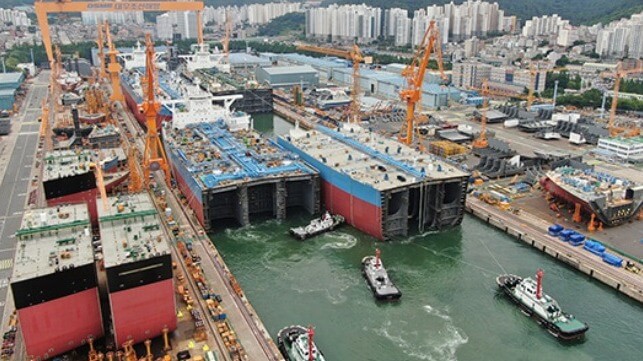Koreans Deny Plans to Breakup DSME and Sell Commercial Unit

Work resumed at South Korea’s Daewoo Shipbuilding and Marine Engineering on Monday after the long strike while questions continued to swirl over the future of the shipyard after the significant losses and deteriorating financial condition. Management is promising to make up for lost time and reporting new orders, while the government-controlled investment bank is denying rumors over its efforts to accelerate the sale of the shipyard.
Over the weekend, management and labor agreed to forego the company’s traditional summer break to make up for lost production at the yard during the 51-day strike by subcontractors. As many as 125 workers have been reported blocking production at the yard with several occupying under construction tankers during the strike. The two-week summer holiday had been due to start today.
Pictures in the Korean media show work resuming at the shipyard this morning. At the same time, DSME management reported a new contract win valued at nearly $500 million. They said they had received an order for two LNG carriers that are scheduled for delivery in November 2026.
At the mid-point in 2022, the shipyard’s management is reporting that it has met nearly three-quarters of its target for orders in 2022. They have received more than $6.4 billion in orders including 20 LNG carriers and six containerships. Management said they are confident that they will meet the full-year target and that their focus is on high-value ships to ease the deepening financial crisis.
Despite the strong orderbook, DSME’s financial losses have continued to mount even before the recent strike which some estimates are saying cost the shipyard nearly $600 million. They reported a loss of nearly $600 million in the first quarter after a loss of nearly $1.3 billion in 2021. Estimates are that the shipyard has lost nearly $6 billion since the Korean Development Bank (KDB) intervened in 1998 and became its largest investor in 2000 to save DSME from bankruptcy.
KDB issued a media statement on Monday denying media reports that it was moving to accelerate the sale of the financially troubled company. Over the weekend, The Korea Economic Daily reported that the bank had retained management consultants at the beginning of 2022 to explore conditions for the shipyard and actions after it became clear that the proposed sale to Hyundai Heavy Industries was likely not to proceed due to EU opposition.
Media reports indicated that the bank is exploring splitting DSME into two units. One would be for commercial work while the other would be for military shipbuilding work. Reports said that they were considering selling the company’s assets in groups as the best course to complete the privatization after several failed previous attempts to sell DSME. KDB last year completed the sale of smaller shipyards including Hanjin and STX.
"The rise in heavy plate prices due to the Ukraine crisis and other conditions in the shipbuilding industry have changed a lot from the time of consulting at the end of last year," KDB said in its statement responding to the media reports. "In the first half of this year, we were in the process of reflecting these new aspects, but the strike broke out and the consulting process was further delayed."
Last week, it was reported that KDB was considering a reorganization of DSME due to the mounting losses due to the strike. The stories said the bank was questioning how much more public monies could be devoted to the shipyard in light of the growing losses.
"Realistically, it is impossible to consider a split-off or spin-off without the results of the consulting," KDB reported. "Once the results come out, we will discuss various ways of selling the company based on the results."
The previous government had pledged to increase support to the overall shipbuilding industry in an effort to build new technologies and support the transition to future ships. The plan was to emphasize alternative fuels and new technologies for enhanced shipbuilding and autonomous operations. Korea’s goal is to expand its leadership in high-value ships such as LNG carriers and the new ammonia and hydrogen technologies.
